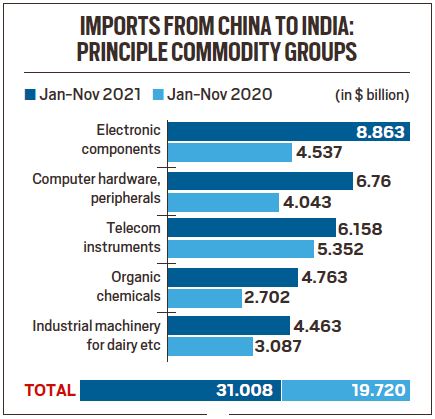Amid renewed concerns of supply-chain disruptions emerging in the wake of the sharp surge in Covid cases in China, the dynamics of the trade equation between India and China may not have much scope to be tweaked in terms of the inputs coming into India from there, at least in the short term.
The rising imports from China, a steady theme through 2021 and much of 2022, is being seen as crucial from India’s perspective as a catalyst for its focussed manufacturing push, with imports of capital goods and intermediate products forming the major chunk of the import basket, officials said. There are also not many import options when it comes to other inputs such as active pharmaceutical ingredients used to manufacture medicines and rare earth minerals that go into electronics and gadgets.


“This is being part of the global supply chain and to make products of that quality, inputs have to be imported and that will take time to get tapered. Electronic components imports from China have almost doubled, but those are essential imports for manufacturing by many telecom manufacturers including for manufacturing iPhone. All countries are now involved in these value chains, can’t wish away with it and only rely on domestic factors. Domestic strength is important from the perspective of an increase in consumption of items like petroleum, oil and lubricants,” a senior government official told The Indian Express.
The recent emerging trend from China’s imports to India has seen a marked shift towards intermediate goods instead of goods for final consumption. “The trend in import data from China is showing that 85 per cent of the goods imported are capital goods and intermediate goods, while 15 per cent are consumption goods,” an official said.
Most of the goods imported from China are capital goods, intermediate goods and raw materials and are used for meeting the demand of fast expanding sectors like electronics, telecom and power in India. The rise in import of electronic components, computer hardware and peripherals, telephone components, etc. can be attributed to transforming India into a digitally empowered society and a knowledge economy. India’s dependence on imports in these categories is largely due to the gap between domestic supply and demand.
Also, raw materials in the form of APIs and drug formulations imported from China are used for making finished products (generic medicines) which are also exported out of India. The electronic components such as mobile phone parts, integrated circuits, video recording or reproducing apparatus etc are used for making finished products (e.g. mobile handsets) which are also exported to other countries.
According to government officials, the PLI schemes in APIs, bulk drugs, key starting materials and Large-Scale Electronics Manufacturing that have been launched by the Centre recently have started to “deliver results” in terms of showing early potential of lowering the dependency on imports.
Story continues below this ad
The PLI Scheme for Large- Scale Electronics Manufacturing that was notified on April 1, 2020, with targeted segments being mobile phones and
specified electronic components, alongside a PLI Scheme for Large-Scale Electronics Manufacturing has attracted large investments from global and domestic companies manufacturing mobile phones and specified electronic components, with the result that the production as well as exports of mobile phones have increased. The imports of mobile handsets have decreased from Rs 48,609 crore in FY15 to around Rs 11,209 crore in FY22, while mobile phone exports from India touched the $1 billion mark (over Rs 8,200 crore) for the first time ever in September 2022. In FY23, mobile phone exports have increased more than $5 billion till October 2022 against $2.2 billion in FY22 during the same period, officials said, citing official data.
The sharp surge in infections is having a short-term impact on the supply chain for solar companies, a statement from the China Silicon Industry Association on Wednesday was quoted by Bloomberg.
China is India’s second biggest trading partner after the United States. Merchandise imports from China have increased to $94.57 billion in 2021-22 from $65.21 billion in the previous year and $60.41 billion in 2014-15. Trade deficit between the two countries has progressively increased to $73.31 billion in 2021-22 from $44.03 billion in 2020-21 and $48.48 billion in 2014-15.
Story continues below this ad
Provisional estimates of trade between India-China for this year shows a trade deficit of $51.50 billion during April-October. Merchandise exports to China from India stood at $8.77 billion, while merchandise imports were at $60.27 billion.
Experts said that given the reported surge of the new Covid variant and the oncoming Chinese New Year, there could be some long-term impact on the electronics industry in India. In 2021, India imported electrical and electronic equipment worth $26.39 billion, according to the United Nations COMTRADE database on international trade.
“With the new Covid-variant that’s been reported and the shortage of labour given the Chinese New Year in four week’s time, there could definitely be certain disruptions. The immediate impact might not be too much since there is currently enough electronics’ channel inventory and sell-in is a bit weak in India, but if the disruption in China persists for more than four weeks, then we can expect a 5-10 per cent market level impact,” Tarun Pathak, research director at market intelligence and research firm Counterpoint told The Indian Express.
The smartphone industry, however, does not foresee any major challenges due to the new variant and is only estimating “sporadic challenges”. “China has had a very resilient export supply chain in the last 3 years in spite of the pandemic and their zero tolerance policy. In the new wave there could be sporadic challenges but by and large we feel that manufacturing and logistics will come through unscathed,” said Pankaj Mohindroo, chairman of the India Cellular and Electronics Association (ICEA).
Story continues below this ad
But, a prolonged disruption could impact electronics component supply chains, experts said. “Indian electronics and smartphone brands have learnt from recent supply chain disruptions, and beefed up their inventory levels. With consumer demand in India traditionally being low in the post-festive period, electronics makers will be in a wait and watch mode on China,” said Prabhu Ram, head of industry intelligence group at CyberMedia Research.



































